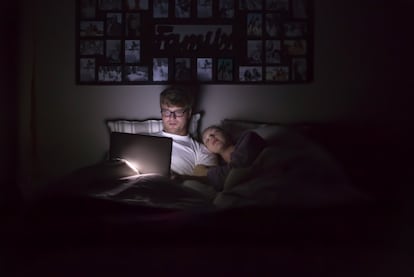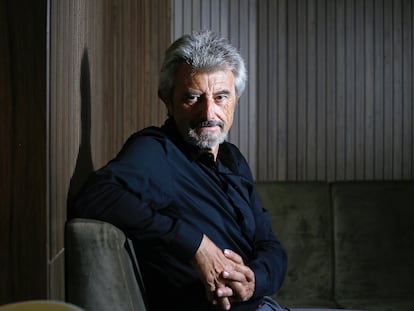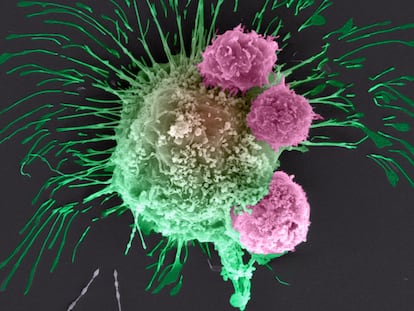The mysteries of circadian rhythms: Why the pancreas is idle at night and active during the day
The human brain has a clock, located in the hypothalamus, which tells the rest of the body what time it is. This readies the body for life-sustaining processes like eating or waking up. But when these bodily mechanisms are disturbed – chronodisruption – it can lead to disease

We all have a central, biological clock that keeps time for our daily lives. It’s part of the hypothalamus, located deep inside the brain, and its main function is to tell the rest of the body what time it is. The human body needs to know the time because its cells and tissue behave differently during the day and night, in the morning or the afternoon. These are our circadian rhythms – biological changes that follow a 24-hour cycle. The central clock works together with the small, independent chronometers in our tissues to anticipate and prepare the cells for upcoming events like lunch or bedtime. Having a properly functioning biological clock is vital because we become susceptible to disease if it slows down or stops.
The central clock is actually an assemblage of 20,000 neurons with small, molecular clocks that are perfectly synchronized through the evolutionary experience of living in the same ecosystem for millions of years, and by the light that enters through the eye’s retina. At different times of the day, certain proteins are activated or expressed more than others. These proteins communicate with the other clocks of the body’s organs to act accordingly, says Antonia Tomás-Loba, who heads the University of Murcia’s (Spain) circadian rhythm and cancer research group. “For 65 million years, evolution has been conditioning our circadian genes to be diurnal animals,” said Tomás-Loba. “We are the product of adaptation to the environment. The circadian rhythms that anticipate daily cyclical changes are an example of this adaptation. At night, circadian rhythms inform the liver that we are not going to eat for a while so that it knows it won’t have to metabolize anything. The liver functions very differently at night than during the day.”
When he served in the British Royal Navy, Aldo Kane was once isolated for 10 days in a nuclear bunker with no natural light or clock. It was an experiment to see how his circadian rhythms were regulated without input from external variables, such as light and social schedules. He could only rely on the natural memory of his own biological clock. Juan Antonio Madrid, a researcher with the University of Murcia’s Chronobiology and Sleep Laboratory who participated in that experiment said that Kane fell asleep a few minutes later each day. In other words, his biological clock generated cycles of more than 24 hours. Kane’s rhythms reverted to normal as soon as he was exposed again to various synchronizing signals, such as an alarm clock going off or a turned-on light.
This external stimulus enters through the retina and lands in the suprachiasmatic nucleus of the hypothalamus, which is where this central clock is located. Certain proteins are activated at different times of the day. The BMAL and CLOCK proteins are activated in the morning and trigger certain genes in cell DNA to signal the time of day. The PER and CRIE proteins are activated in the afternoon and concentrate in the cells to block BMAL and CLOCK activity until the following morning. This whole time-keeping process regulates the sleep-wake cycle, as well as other human metabolic and behavioral processes.
That’s why experts say it’s a bad idea to confuse the biological clock and expose your system to light from a computer screen late at night. “If I’m still being exposed to blue light from a computer screen at midnight, my central clock interprets this as daytime and tells my liver clock that it’s time to start working. That’s when a molecular conflict occurs because I’m sending information that desynchronizes the clocks,” said Tomás-Loba. A 2015 scientific review published in Chronobiology International found that exposure to artificial light at night suppresses melatonin secretion, triggers sleep onset latency and accelerates alertness. This circadian disruption, says Tomás-Loba, could have negative effects “on psychological, cardiovascular and metabolic functions.”
Madrid says that there are other “synchronizers” besides light that help calibrate the central clock. “In addition to environmental time, which is the natural cycle of light and dark, we have social time. These are time-related habits, such as going to work or social interaction, which assist in the synchronization process. We also have metabolic time. An example would be mealtimes, which help synchronize and regulate the clocks of the digestive tract and liver.” A recent study published in Science demonstrated that synchronizing food consumption with the circadian clock mitigates obesity in mice. The mice that ate during the active phases of their circadian cycles burned more calories, which lowered the risk of obesity.
Jet lag
Our clocks go slightly out of sync in the absence of light, but they don’t stop altogether. As the experiment with Aldo Kane demonstrated, circadian rhythms continue to function, but with less precision. Jet lag is well-known example of this functional decline, says Salvador Aznar Benitah, who heads the Stem Cell and Cancer laboratory at the Institute for Biomedical Research in Barcelona. “If the circadian rhythm only responded to light, our clocks would quickly adapt when we travel to another time zone. But what actually happens is that there is an initial, temporary mismatch when we abruptly land in a different time zone. After a while, the internal clock adjusts and aligns with the new light conditions.”
The central clock in the hypothalamus synchronizes with all the independent clocks in the body’s tissues. It acts like a bandleader by setting the rhythm of the day and informing the body of the time. “Circadian rhythms prepare the organism for what is about to happen,” said Aznar. “During the hours of strong sunlight, for example, the skin has to deal with ultraviolet light. So it triggers protective mechanisms like melanocytes, which is akin to putting on sunscreen before going outside. Early in the morning, the clocks of the skin cells anticipate exposure to daylight and activate melanocytes. Later in the afternoon, the skin cell clocks know not to activate the genes that turn on melanocytes, and that skin activity stops.”
In 2019, Aznar published a paper in Cell describing how tissue clocks operate independently from the central clock. “Each tissue has its own, autonomous clock. It doesn’t need anyone to tell it what to do. This autonomy ensures longevity by avoiding a domino effect if one tissue clock fails. The central clock functions as a coordinator so that all the tissue clocks know what time it is. If that coordination fails, then certain errors or mutations can occur.”
The pancreas also changes over a 24-hour period, says Madrid. “It’s sluggish at night and very active during the day. When you consume sugar at night, the pancreas responds poorly because it doesn’t produce enough insulin, and the insulin it does produce has a different effect from the insulin produced during the day.” Why? Because the changes in the organs are logical, not random. “During the night, our body is programmed to conserve and maintain stable levels of glucose during the long fasting period between dinner and breakfast,” said Madrid. Glucose can be conserved because the tissues that use it as fuel to feed their cells become more resistant to the effects of insulin, which is the hormone that introduces glucose into the cells. All these changes, says Madrid, are programmed by the body’s biological clocks.
Chronodisruption
Disruptions to circadian rhythms are harmful to the body. “We have three types of time that regulate our chronobiology,” said Tomás-Loba. “We have internal time, which is the time that our cells sense after having adapted to our individual ecosystems. We have external time, which is established by sunlight and artificial light. And we have social time, which is established by when we go to work or eat. If these three types of time get out of sync, a molecular and physiological imbalance called chronodisruption appears.”
Tomás-Loba’s team is currently studying the health impacts of social jet lag, which results from having different sleep schedules on weekdays and holidays. In one experiment, they found that when mice slept later than usual on weekends, their metabolisms were affected. “The molecular clocks of several organs were not synchronized because they didn’t know what time it was. That influenced how the immune system functioned, for example,” said Tomás-Loba. Several studies have reported that when people work nighttime shifts for an extended period, there is an increased risk of developing certain hormone-dependent tumors, such as breast and prostate cancer.
Aznar notes that our biological clocks begin to deteriorate between the ages of 45 and 50. “We have a good understanding of how the clock works, but we are still novices when it comes to knowing how the different tissues synchronize. If we understood how the clock gets thrown off, we could develop therapies to fix the problem.”
Tomás-Loba says there are several internal and external triggers that lead to body clock disruptions. “Light is the factor that has been studied the most, but food consumption is a daily activity, and eating at noon is not the same as eating at 4am. Exercise is also important – we should be active during the day because we are diurnal mammals. Noise is another obvious chronodisruptor, although there is much more to be studied there.”
Madrid, who just published a book on chronobiology, says that chronodisruption develops over time and is not triggered by a single event. “The biological clock deteriorates as we age, and our interactions with external synchronizers change. The chronodisruption factors for young people are usually external – the synchronizers to which they are exposed become misaligned. For example, too much light at night, snacking between meals with no set mealtimes and sedentary lifestyles.” Diseases and alterations in circadian rhythms are also communication vehicles. “An imbalance in the clock can cause a disease to develop or progress. Some examples are depressive disorders, memory problems, insomnia and reproductive disorders. But chronodisruption can also result from pathologies such as chronic kidney disease, sleep apnea and decompensated Type 2 diabetes,” said Madrid.
Clock desynchronization can be rectified and chronodisruption is reversible if the individual is re-exposed to the appropriate synchronizers. The problem, says Tomás-Luba, is when individuals are chronically exposed to stimuli that desynchronize all three types of time. “We are at a point where we are not listening to our bodies. We feel hungry at midnight because we eat dinner at 3pm. We are losing synchronization with our ecosystem,” said Tomás-Loba. Ultimately, human beings are the result of an evolutionary process that uses nature as a reference point, “and our relationship with nature is being lost,” warned Madrid.
Tu suscripción se está usando en otro dispositivo
¿Quieres añadir otro usuario a tu suscripción?
Si continúas leyendo en este dispositivo, no se podrá leer en el otro.
FlechaTu suscripción se está usando en otro dispositivo y solo puedes acceder a EL PAÍS desde un dispositivo a la vez.
Si quieres compartir tu cuenta, cambia tu suscripción a la modalidad Premium, así podrás añadir otro usuario. Cada uno accederá con su propia cuenta de email, lo que os permitirá personalizar vuestra experiencia en EL PAÍS.
¿Tienes una suscripción de empresa? Accede aquí para contratar más cuentas.
En el caso de no saber quién está usando tu cuenta, te recomendamos cambiar tu contraseña aquí.
Si decides continuar compartiendo tu cuenta, este mensaje se mostrará en tu dispositivo y en el de la otra persona que está usando tu cuenta de forma indefinida, afectando a tu experiencia de lectura. Puedes consultar aquí los términos y condiciones de la suscripción digital.
More information
Últimas noticias
ICE raids trigger school absenteeism and traumatize children: ‘They have been forced to leave their childhood behind’
The life of a delivery driver in China: ‘Many people don’t know how an order can arrive at their home in just one day’
Maude Apatow, from acting in ‘Euphoria’ to directing: ‘There are many films that you can tell weren’t written by someone young’
Families demand repatriation of bodies of Colombians who died in Ukraine: ‘This war is a slaughterhouse for foreigners’
Most viewed
- Christian Louboutin: ‘Young people don’t want to be like their parents. And if their parents wear sneakers, they’re going to look for something else’
- US sanctions against jailed cartel leader ‘El Marro’ highlight Mexico’s lack of control over its prisons
- Cartels in Mexico take a leap forward with narco-drones: ‘It is criminal groups that are leading the innovation race’
- Liset Menéndez de la Prida, neuroscientist: ‘It’s not normal to constantly seek pleasure; it’s important to be bored, to be calm’
- ‘El Limones’ and the growing union disguise of Mexican organized crime











































